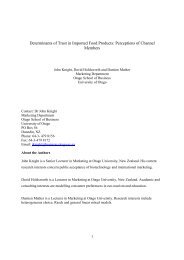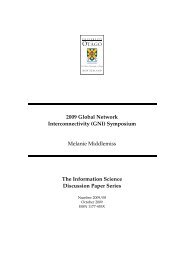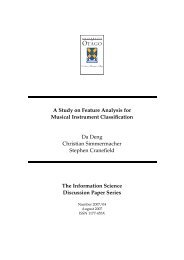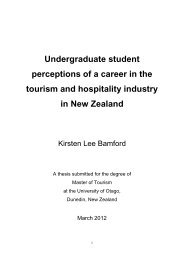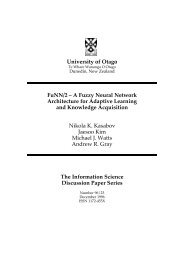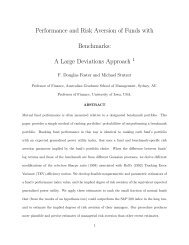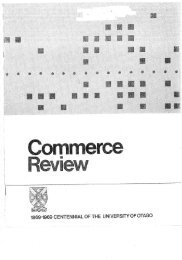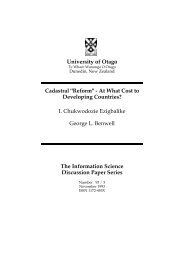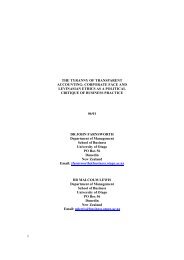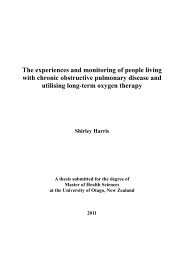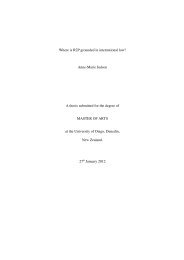Reframing perceptions of anthropomorphism in wildlife film and ...
Reframing perceptions of anthropomorphism in wildlife film and ...
Reframing perceptions of anthropomorphism in wildlife film and ...
Create successful ePaper yourself
Turn your PDF publications into a flip-book with our unique Google optimized e-Paper software.
CHAPTER 4) ANTHROPOMORPHISM REACHES THE MASSES<br />
‘We're not look<strong>in</strong>g to be a natural history channel. We're look<strong>in</strong>g to be an enterta<strong>in</strong>ment<br />
dest<strong>in</strong>ation.’<br />
- Majorie Kaplan (President <strong>of</strong> Discovery Communications, 2008)<br />
4.1) Animal Reality Television <strong>and</strong> the Docu-soap<br />
Popular factual program networks like Discovery Communications, whose channels<br />
<strong>in</strong>clude Animal Planet <strong>and</strong> Discovery Channel, broadcast to some 370 million<br />
households worldwide (Discovery 2010). The use <strong>of</strong> <strong>anthropomorphism</strong> with<strong>in</strong> the<br />
competitive television broadcast<strong>in</strong>g networks is therefore an important consideration <strong>in</strong><br />
this thesis, with enterta<strong>in</strong>ment-driven representations <strong>of</strong> animals becom<strong>in</strong>g<br />
commonplace <strong>and</strong> globally distributed (Pierson 2005, D<strong>in</strong>gwall <strong>and</strong> Aldridge 2006).<br />
In the current rat<strong>in</strong>gs-driven era <strong>of</strong> cable television programm<strong>in</strong>g, <strong>wildlife</strong><br />
documentaries have been subject to format diversification (Bouse 1998, Pierson 2005,<br />
Horak 2006, Kilborn 2006). The competitive market has seen the st<strong>and</strong>ard ‗blue-chip‘<br />
formats <strong>of</strong> the 1970‘s <strong>and</strong> 80‘s largely disappear, to be replaced by the action <strong>and</strong> drama<br />
that human Reality Television can provide. In response, <strong>wildlife</strong> broadcasters like<br />
Animal Planet have developed a range <strong>of</strong> survival strategies; marry<strong>in</strong>g <strong>wildlife</strong><br />
documentary with other television genres like Reality TV <strong>and</strong> develop<strong>in</strong>g <strong>in</strong>novative<br />
<strong>film</strong>mak<strong>in</strong>g techniques to ma<strong>in</strong>ta<strong>in</strong> rat<strong>in</strong>gs <strong>and</strong> keep costs down. These format<br />
diversification strategies have been criticised by <strong>film</strong> theorists (Kilborn 2006, Eisenberg<br />
2003). Further discussion <strong>of</strong> their use, <strong>in</strong> particular the use <strong>of</strong> <strong>anthropomorphism</strong>, is<br />
necessary to determ<strong>in</strong>e if their popularity with viewers can provoke a behavioural<br />
change <strong>in</strong> the audience.<br />
Wildlife docu-soaps or docu-dramas are an example <strong>of</strong> recent cross-genre programm<strong>in</strong>g<br />
<strong>and</strong> are arguably the best example <strong>of</strong> anthropormorphism <strong>in</strong> televised nature<br />
programm<strong>in</strong>g to date. Deliberately creat<strong>in</strong>g <strong>and</strong> nam<strong>in</strong>g characters, docu-soaps follow<br />
the day-to-day activities <strong>of</strong> a group <strong>of</strong> animals, dramatis<strong>in</strong>g their lives <strong>in</strong> just the way a<br />
human soap opera or Reality TV series does. In September 2005, Discovery<br />
Communication‘s Animal Planet channel launched its telenovela-style nature series,<br />
Meerkat Manor. The series, Animal Planet‘s most successful to date, follows the lives<br />
22




